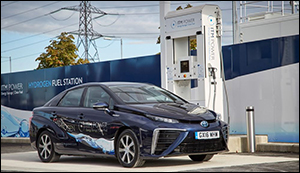New Membrane Technology That May Help Make Hydrogen Fuel Cell Vehicles Viable
28. 8. 2017 | Worcester Polytechnic Institute | www.wpi.edu
Separation membranes hold the key to making hydrogen fuel cheaper; in a pioneering study, the researchers show that membranes made with liquid metals appear to be more efficient at separating hydrogen than conventional palladium membranes while also being less expensive and more durable.
While cars powered by hydrogen fuel cells offer clear advantages over the electric vehicles that are growing in popularity (including their longer range, their lower overall environmental impact, and the fact that they can be refueled in minutes, versus hours of charging time), they have yet to take off with consumers. One reason is the high cost and complexity of producing, distributing, and storing the pure hydrogen needed to power them, which has hindered the roll-out of hydrogen refueling stations.

The hydrogen can then be separated from the other gases through a cumbersome, multi-step chemical process, but the cost and complexity of hydrogen production can be reduced by using a membrane to do the separation. Most of the hydrogen separation membranes currently being developed use the precious metal palladium, which has unusually high hydrogen solubility and permeance (which means that hydrogen easily dissolves in and travels through the metal, while other gases are excluded). But palladium is expensive (it currently sells for about $900 per ounce) and fragile.
For these reasons, chemical engineers have long searched for alternatives to palladium for use in hydrogen separation membranes, but so far, no suitable candidates have emerged. A pioneering study led by Ravindra Datta, professor of chemical engineering at Worcester Polytechnic Institute (WPI), may have identified the long-elusive palladium alternative: liquid metals.
Read more at Worcester Polytechnic Institute
Image Credit: Worcester Polytechnic Institute
-jk-




